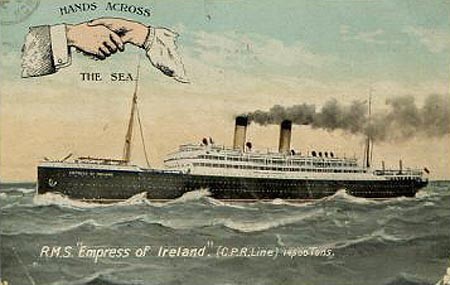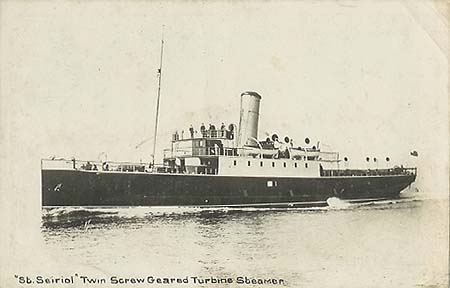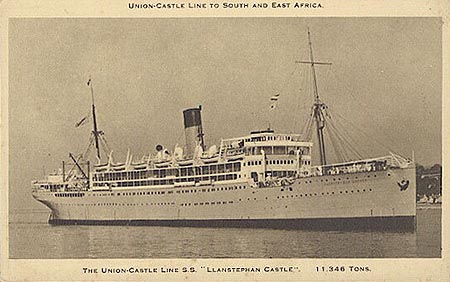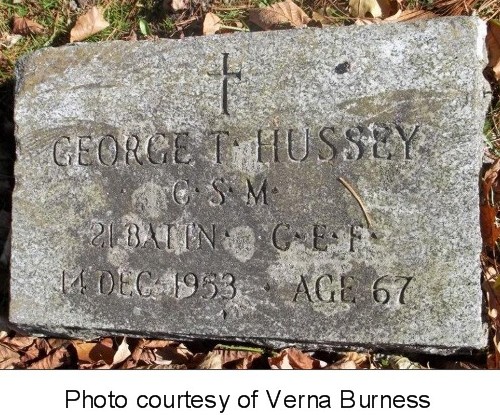|
Mar 19, 1886
|
Born in Camberwell, London,
England to George Albert and Ann Elizabeth (nee Diett) Hussey
|
|
Dec 25, 1907
|
Married to Edith Florence
Overton in St. Andrew’s Church, Battersea, London, England
|
|
Jun 3, 1910
|
Embarked the SS Empress of
Ireland in Liverpool with his wife and 2 children

|
|
Jun 9, 1910
|
Disembarked in Quebec City,
Quebec and proceeded to Port Hope, Ontario
|
|
Oct 19, 1914
|
Shown on the payroll of the 46th
Durham Regiment in Port Hope
|
|
Nov 6, 1914
|
Attested into the 21st Battalion in
Kingston, Ontario
Ø Number 59490 (temporary number 1083)
Ø Next of kin given as Mrs. GT Hussey, wife, Dorset
St. E., Port Hope, Ontario
Ø Previous occupation given as Enameller
o
Later noted as
Porcelain Enameller
Ø No previous military experience given
Ø Religion given as Church of England
Ø Posted to “G” Company
o
Later noted as
Depot Company and shown as a Bugler
The 21st Battalion trained in the
Kingston, Ontario area through the winter of 1914-15.
|
|
Nov 12, 1914
|
After receiving the
anti-typhoid inoculation, George Hussey suffered a reaction to the needle and
was admitted to the Kingston Hospital
|
|
Nov 14, 1914
|
Discharged to duty from
hospital
|
|
May 6, 1915
|
Embarked the RMS Metagama in
Montreal, Quebec

|
|
May 15, 1915
|
Disembarked in Devonport,
England and the battalion proceeded to the West Sandling Camp, near Hythe,
Kent to continue training
|
|
Jul 14, 1915
|
Appointed to the rank of Lance
Corporal
|
|
Aug 28, 1915
|
Posted to “C” Company
|
|
Sep 14, 1915
|
Embarked the St. Seiriol in
Folkestone

|
|
Sep 15, 1915
|
Disembarked in Boulogne,
France and the battalion proceeded to St. Omer
|
|
Nov 9, 1915
|
Admitted to the No. 5 CFA
(Canadian Field Ambulance) with a diagnosis that reads Influenza
|
|
Nov 10, 1915
|
Transferred to the Division
Rest Station at Loker, Belgium
|
|
Nov 15, 1915
|
Discharged to duty from the
rest station
|
|
Dec 2, 1915
|
Admitted to the St. John’s
Ambulance Brigade Hospital in Etaples, France with a diagnosis that reads
Arthritis
|
|
Dec 7, 1915
|
Invalided to England and admitted
to the Manor House Hospital in Folkestone
|
|
Dec 11, 1915
|
Transferred to the VAD
(Volunteer Aid Detachment) Hospital in Ashford
|
|
Feb 12, 1916
|
Transferred to the Granville
Canadian Special Hospital in Ramsgate
Notes on admission
Ø Suffers from pain
in lumbar region, right hip, leg muscles, knees and ankles
Ø Ankles are stiff
and swollen
Ø Patient is very
nervous due to shell shock and sleeps badly and wakens frightened
Ø Hearing is poor in
left ear caused by shell explosion
Ø Exercise
recommended
|
|
May 29, 1916
|
Now fit for light duties
|
|
Jun 22, 1916
|
Discharged from hospital and transferred
to the 39th Reserve Battalion at West Sandling
|
|
Jun 30, 1916
|
Medical Board at West Sandling
notes
Ø Patient suffers
from Nervous Debility
Ø Suffers from
shortness of breath and headaches
Ø Man is generally
run down
Ø Board recommends 4
weeks of Physical Training at the Monks Horton Hospital
|
|
Feb 27, 1917
|
Appointed to the rank of
Acting Sergeant with pay
|
|
Apr 16, 1917
|
Transferred to the 3rd
CCD (Canadian Command Depot)
|
|
Apr 10, 1918
|
Appointed to the rank of A/CSM
(Acting Company Sergeant Major) with pay
|
|
Jul 2, 1918
|
Transferred to the Canadian
General Depot and reverted to the permanent rank of Private pending return to
Canada
|
|
Jul 9, 1918
|
Transferred to the CDD
(Canadian Discharge Depot) in Buxton pending return to Canada
|
|
Sep 19, 1918
|
Attached to the Canadian Discharge
Depot in Shorncliffe pending return to Canada
|
|
Sep 24, 1918
|
Embarked the Llanstephan
Castle in London

|
|
Oct 8, 1918
|
Disembarked in Montreal,
Quebec and proceeded to Toronto, Ontario where he was Taken On Strength the
CAGS (Canadian Army Gymnastics Staff) as an instructor at Hart House, Toronto
|
|
Jan 7, 1919
|
Transferred to the Whitby
Military Hospital and employed as an instructor
|
|
May 15, 1919
|
Transferred to the Military
School OS & P (Orthopedic Surgery and Physiotherapy) and attached to the
Whitby, Ontario Military Hospital as a Remedial Instructor
|
|
Jun 27, 1919
|
Attached to the St. Andrews
Military Hospital in Toronto as an Instructor
|
|
Nov 11, 1919
|
Admitted to the St. Andrews
Military Hospital as a patient with a diagnosis that reads Rheumatic Fever
|
|
Nov 26, 1919
|
Surgery performed to remove
his tonsils as they had become infected
|
|
Dec 10, 1919
|
Transferred to the AMCTD (Army
Medical Corps Training Depot) for pay purposes while in hospital
|
|
Mar 1, 1920
|
VDH (Valvular Disease of the
Heart) was added to his diagnosis
|
|
Mar 17, 1920
|
Medical Board held at St. Andrew’s
Hospital notes
Ø Patient suffers
from Rheumatism and hearing loss
Ø Also suffers from
Valvular Disease of the Heart
Ø Heart is slightly
enlarged and murmurs are present
Ø Has pain in most of
his joints
Ø Becomes breathless
on exercise
Ø Board recommends
hospital care for 4 months then care as an out-patient for 6 months under
care of the DSCR (Department of Soldier Civil Re-establishment)
|
|
Mar 25, 1920
|
Transferred to the Dominion
Orthopedic Hospital in Toronto with issues with his previous tonsillectomy
|
|
Mar 30, 1920
|
Discharged to duty from
hospital
|
|
Apr 6, 1920
|
Discharged from the CEF in
Toronto, Ontario
Ø Rank on discharge
CSM
Ø War Service Badge
Class “A” issued number 98981
Ø Discharged to the
care of the Department of Soldier Civil Re-establishment
Ø Proposed residence
on discharge Dorset St. E., Port Hope, Ontario
Following his discharge, the
1914-15 Star, British War Medal, and Victory Medals were sent to him at 475
Princess St., Kingston, Ontario
Following his discharge,
George Hussey served with the Secretary of State Department in Ottawa for 28
years before his retirement
|
|
Dec 14, 1953
|
George Thomas Hussey died of
congestive heart failure while a patient of the Veterans Pavilion of the
Ottawa Civic Hospital, Ottawa, Ontario.
He was later buried in the Cataraqui Cemetery, Kingston, Ontario

|
|